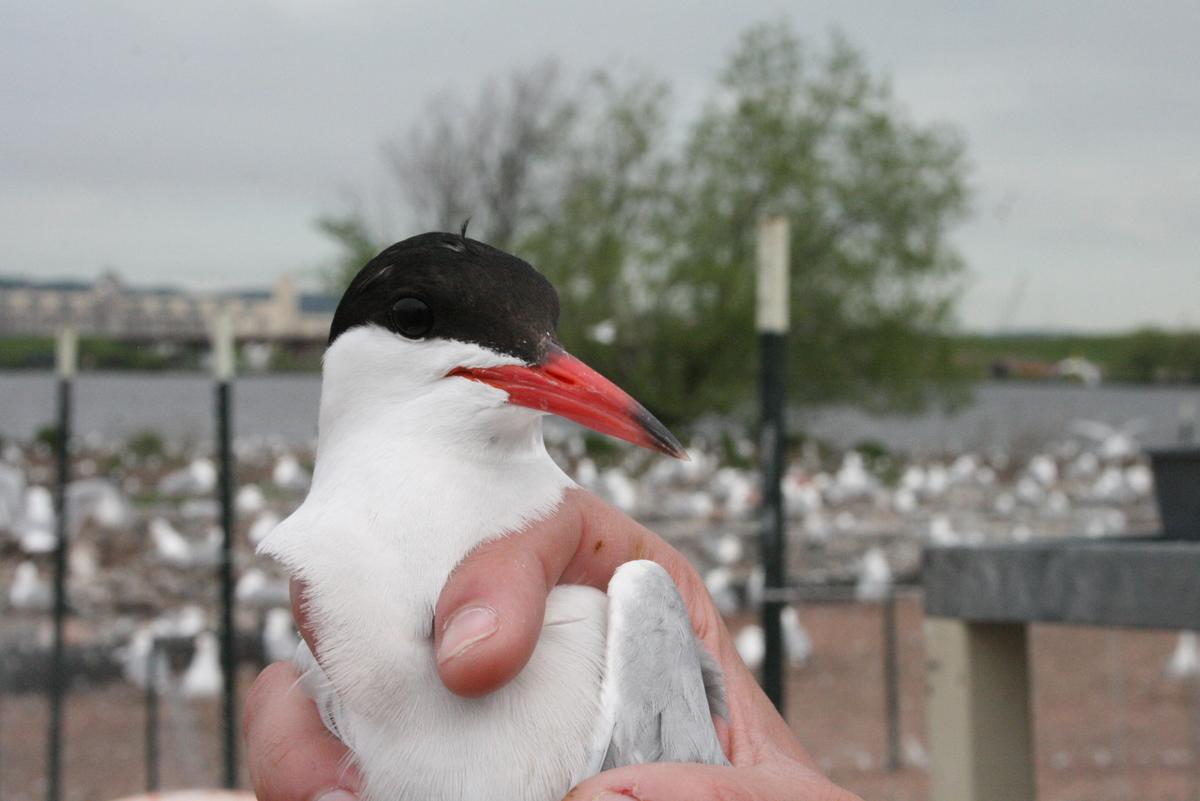Her current research is focused on the common tern, a bird listed as threatened in Minnesota and endangered in Wisconsin, with just two colonies left to study on Lake Superior. On Interstate Island, in the St. Louis River Estuary, is one of the struggling colonies.
The challenge for the birds (and, hence, the researchers) is obvious – the island is overrun by ring-billed gulls.
Overrun is too mild a term, actually. Covering its seven acres are some 13,000 breeding pairs of gulls flapping and squawking and protecting eggs and chicks scattered on the ground. But in the middle of this brown, largely unvegetated island is a bit of reprieve from gull-mania.
A series of long alleys are stringed off to discourage gulls while leaving space for the terns to nest and hatch their young. Terns are agile flyers that can drop down into the exclosure and around the string.
It’s a brutal life on Interstate Island. The ring-billed gulls will eat tern eggs and chicks, given the opportunity. Also nesting on the island are a few dozen herring gulls which sometimes make meals of the ring-billeds. It’s every bird for itself.
But on this particular visit to the island, Bracey and veteran tern researcher Fred Strand, counted 63 new tern nests, adding to the 97 nests already counted. Strand, now retired but still contracting his services, has been managing the two tern colonies for the Wisconsin Department of Natural Resources for over 25 years.
“I got interested in this project because these birds are regionally threatened and there’s 20 years of banding and nesting data that already exists,” said Bracey. “So I wanted to do a larger study on where they are when they’re not here, to add to what we know about their breeding grounds here.”
The tern’s colony-life, plus tiny technology, makes her data-gathering possible. Leg bands with a geolocator, weighing just three grams, are attached to the birds’ leg. The terns come back to the same location every year to nest so the researchers can collect the data. The geolocators use a light meter to record ambient sunlight to estimate annual movement patterns.
“Our birds are really good candidates for this technology,” Bracey explained. “They spend a lot of time out in the open, on coastlines, so there’s not a lot of shading to throw it off. Our data is pretty clean.”
What she wants to know is what the terns might be encountering while they’re away from Interstate Island and the second research site in Chequamegon Bay, near Ashland, Wisc. She’ll learn migration routes, where they winter, how long they stay in their winter locations, as well as timing of migration and flight speed.
“So we can see if they migrate to Peru, we know it’s a huge fishing area. Could over-fishing be a problem?” Bracey asked. “There’s also small scale gold mining which has a lot of mercury pollution associated with it.”
On Interstate Island, Bracey and Strand set up simple box traps over nests where birds are actively incubating eggs. Blood and feather samples are taken to note their gender (males and females look alike) and test for mercury. Banding identification is noted, and geolocators are attached before sending the birds on their way again quickly.
Convincing the terns to nest inside the fenced area took a bit of ingenuity. Bracey put life-sized decoy terns in the fenced area and then added tern vocalization.
“The sound machines cost, like, $2,500 and that was too expensive,” she said. “So I explained what I needed to (NRRI Machinist) Steve Johnson and he built it for next to nothing.” Testing the machine filled the halls of NRRI with tern calls for a week.
But the decoys and nesting tern noises worked and the researchers found two dozen terns nesting inside the exclosure, near the sound machine. They also set up cameras to monitor the terns behavior and predation activity.
In spite of the gulls squawking, swooping and pooping, Bracey said she enjoys being on the island and studying the common terns.
“Anything you study and spend time with, you have a greater appreciation for,” she said. “They’re strong flyers. They travel far. They’re fun to watch. I love it out here.”
